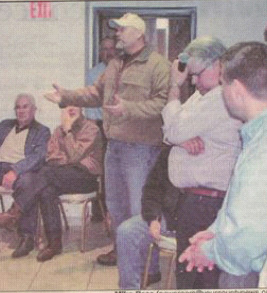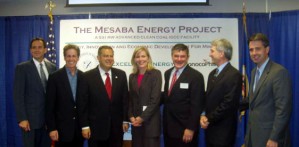78 MW of Solar PV in New Jersey?
March 14th, 2010
This is a map of the footprint of the 78MW Stella Solar and Atlantic Green Power project proposed for Upper Pittsgrove, New Jersey. I’ve ehard there are others planned nearby, but that this is the biggest.
Project description from Atlantic Green Power Holding Company 3Q 10-Q filing:
There are two meetings coming up about this project:
Informational Meeting
Elmer Grange Hall
Tuesday, March 16, 2010 from 6 to 8:30 p.m.
and the Land Use meeting where the town will approve or deny the application:
Upper Pittsgrove Town Hall
Thursday, March 18, 2010 at 7:30 p.m.
Now you all know how I love solar, from the solar hot water my father designed for the Minnesota Zoo to those simple little heaters you can make or buy:
Every house needs these simple solar heaters.
Solar PV should also be on the roof of every big box there is, and on every home. But to be clear, I don’t think it belongs covering prime ag fields a long way from load. That isn’t “highest and best use,” and just doesn’t make sense when you consider the capacity factor of solar and the line loss over transmission. So, this project seems odd…
Why do it? Well, look who is involved and the incentives — means, motive and opportunity — and given that, I hope the town will take a close look before jumping, at the very least, require these conditions (off the top of my head):
- No ag land be removed from production; and
- No ag land be removed from ag preservation designation; and
- Commercial solar be limited to commercial and industrial areas; and
- Commercial solar be limited to roofs in rural areas.
WHO IS GOING TO BUY THIS POWER?
LET’S SEE THE POWER PURCHASE AGREEMENT!
The article way below, from Today’s Sunbeam, says it is to be built on land that “is currently owned by Ed Stella and will be leased to Atlantic Green Power…” but the Atlantic Green Power site says that Edward Stella, Jr., is the “Vice President of Project Development.” From what I can see, this is their FIRST project. Edward Stella as VP? Really, it’s right here, so we’re not exactly talking about an arms length transaction:
Edward Stella, Jr.
Vice President of Project Development, Director
If he’s connected to “such customers as Scott’s, Coastal Supply, Home Depot and Lowes” why aren’t they putting solar on the roofs of those big boxes, where it can be used, and not on prime ag land far away from big boxes?
Atlantic Green Power Holding Company has been in existence since September 17, 2009, and Edward Stella, Jr., has been “Vice President of Project Development” and a “Director” for all of a month.
A press released based blurb provides two sources for more information:
Robert Demos, Jr., President & CEO of Atlantic Green Power Holding Company
and
Howard Greene, Greene Inc., and CLICK HERE FOR GREENEINCPR.COM — HA!!
So now, let’s look at Lodestar Mining… from their site, their ONLY press release listed posts these links for Atlantic Green Power and Lodestar. CLICK ON THESE LINKS THAT THEY PROVIDED:
LGST – their own link says “There are no All Market results”
Hmmmmmmmmmmm…
CLICK HERE for Lodestar’s 10-Q for the year ending June 30, 2008, with this statement:
CLICK HERE FOR LATE FILED 2008 10-K.
From their 10-K regarding their one option contract:
And this snippet:
And again, a statement of its tenuous existence as a going concern:
And again, the solar project particulars:
Pittsgrove Solar Farm
Something that caught my eye on their site — which is repeated in the SEC 3Q 10-Q filing — a press release that talks about the ARRA incentive, a 30% cash payment in lieu of federal investment tax credit, and federally guaranteed loans and a 30% investment tax credit. Seems ALL of those would apply here, so let’s say Mr. Stella is “motivated.”
Here’s the article from Today’s Sunbeam:
Photo from the Country News – Does MOES’ Larry Hartman have a headache? Is he dreaming of retirement? He IS holding on to the microphone, word has it that people such as the speaker here, Dean Bungum, weren’t given the microphone to speak. It was standing room only for the MOES public meeting for the wind project going up on Dexter.
On March 4, Thursday, it was the same scene in Mazeppa for the Goodhue Wind Project… Oh, the AVA Goodhue Wind Project, the names have been changed to protect … nevermind. We don’t know why the name was changed. But there are new people involved. How does that change in ownership affect the already questioned C-BED status of this project?
They held the Goodhue meeting in Mazeppa? Why? Why not in Goodhue County? Why not at the Goodhue Lions Club? Why not at the Zumbrota school? Or the Legion on 58 in the middle of town…
There are some significant deadlines in the Goodhue Wind Project. Oh, first, to look up the dockets on PUC site:
CLICK HERE FOR PUC DOCKET SEARCH
Search for 09-1186 (Certificate of Need); 08-1233 (Siting) and 09-1349 & 09-1350 (Power Purchase Agmts)
IMPORTANT DATES:
March 15 – Comments in PPA Dockets on Xcel’s request for amendment – send to stuart.mitchell@state.mn.us and burl.haar@state.mn.us and file on eFiling if you can.
March 26 – Comments for scope of Environmental Report for Siting & Certificate of Need – send to larry.hartman@state.mn.us
March 29 – Reply Comments in PPA Dockets about others comments on Xcel’s request for amendment – send to stuart.mitchell@state.mn.us and burl.haar@state.mn.us and file on eFiling if you can.
Holler if questions!
Mesaba Siting Recommendation?!?!?!
December 30th, 2009
WTF?
The ALJ’s recommendation has come out in the Excelsior Energy Mesaba Project docket and he’s recommended that a permit be issued. Really…
This is the judge who tossed out my client, Public Intervenors – Mesaba, Xcel Energy and Minnesota Power because we didn’t file testimony. Show me in the rules where filing testimony is required…
THERE WERE NO PARTIES IN THIS DOCKET, JUST EXCELSIOR ENERGY.
Read it for yourself:
I’m at a loss about what to say…
Let Mesaba go…
December 19th, 2009
Jorgensen’s got to get over it — Mesaba is done, ain’t happening, dead, dead dead, yet she’s spinning those tales and hype about Excelsior Energy’s Mesaba IGCC Project. From the first words in the title, it’s lies, lies and more lies, oh, and misrepresentations and falsehoods and exaggerations and utter bullshit too! Why does the St. Paul Pioneer Press give her space forthis advertising of the nonsensical kind?
Here’s what Citizens Against the Mesaba Projet’s Charlotte Neigh had to say about it:
Julie Jorgensen is using the opportune hook of the Copenhagen conference to repeat Excelsior Energy’s same old, self-serving promotional claims about the “clean coal” technology of its Mesaba Energy Project. One must wonder why the Press unquestioningly allots opinion space to the promoter of a precarious for-profit venture, financed almost exclusively by $40 million in public funds, which have been benefiting the author and her co-founder husband, Tom Micheletti.
What Jorgensen didn’t say:
• The U.N. negotiators in Copenhagen decided to leave carbon capture and storage, the prime objective of the IGCC technology touted by Excelsior Energy, off the list of clean-energy projects eligible for the Clean Development Mechanism; the 12/17/09 Wall Street Journal reported that “clean coal seems to be getting the cold shoulder at the climate summit”, and “. . . clean coal is anything but viable right now”.
• Mesaba’s Unit I would emit 5 million tons of carbon dioxide per year and the Department of Energy has acknowledged that capturing and sequestering the CO2 from the proposed Taconite plant is not feasible.
• The claimed economic benefit has been rejected by the Minnesota Public Utilities Commission, which found the project too expensive and risky and not in the public interest.
• The need for this Project has never been proven; no utility is willing to buy its output; Xcel Energy successfully resisted efforts to force it into a power purchase agreement; and the MPUC has declined to require other utilities in the state to include Mesaba’s output in their resource plans.
• The environmental claims are yet to be adjudicated as the MPUC considers the route and siting permits and other government agencies pursue their concerns related to air, water and waste permits.
Is Jorgensen’s piece really that bad? See for yourself:
Julie Jorgensen: We need baseload power. Coal’s plentiful. Let’s clean it up
By Julie Jorgensen
Updated: 12/17/2009 05:54:25 PM CSTI’m the co-founder of Excelsior Energy, which is developing the Mesaba Energy Project, an IGCC power plant near the town of Taconite on Minnesota’s Iron Range. From my point of view, IGCC offers economic and environmental benefits to Minnesota. The Midwest is poised be a leader in the delivery of this technology. Gov. Tim Pawlenty and the Minnesota Legislature have supported the development of Minnesota’s IGCC plant, the Mesaba Energy Project, since 2003, and the project has been exempted from a statewide prohibition against new coal plants. Eleven Midwest governors established a collective goal to spur construction of at least five commercial-scale IGCC plants by 2015, and President Obama announced a goal to build five such “first-of-a-kind” clean coal plants. The U.S. Department of Energy (DOE) has provided significant funding and incentives to the Mesaba Project to offset the costs of needed innovation.
Adoption of IGCC technology is essential to cleaning up coal and mitigating climate change.
As fears mount about global warming, environmental advocates like the Clean Air Task Force and the Natural Resources Defense Council support the timely and widespread commercialization of IGCC technology. From a global perspective, the importance of commercializing a cleaner way to use coal cannot be understated: both India and China have vast coal reserves, which they will inevitably use in the cheapest and easiest possible ways to fuel their growing economies.
Additionally, the costs of new nuclear facilities may put them out of reach.
Julie Jorgensen is the former CEO of CogenAmerica, a publicly traded independent power company, and a former executive of NRG Energy, a global energy development company. She’s a co-founder of Excelsior Energy Inc., which is developing a coal gasification plant near Taconite on Minnesota’s Iron Range. Her e-mail address is JulieJorgensen@ExcelsiorEnergy.com.
Lent Twp voters say NO! to LS Power
December 17th, 2009
From ECM article…
On Monday, citizens of Lent Township organized a Special Meeting, as allowed under statute, and told the Town Board what they thought of LS Power’s Sunrise River Energy Station. The hands raised you see in the photo is the vote telling the board that they should not approve a development agreement with LS Power.
The people say NO, but the township, the following day, went ahead and approved the Development Agreement:
Power Plant Gets Township Approval
And a view from the trenches:
And here’s the report from the Post Review:
Citizens’ vote was to nix power plant
The folks were divided by Lent residency and non-residency.
There were separate sign-in sheets and designated seating areas.
First order of business was the Pledge of Allegiance.
Milles went on to read the resolution.
All of the above was accomplished Monday night.
Read the rest of this entry »







